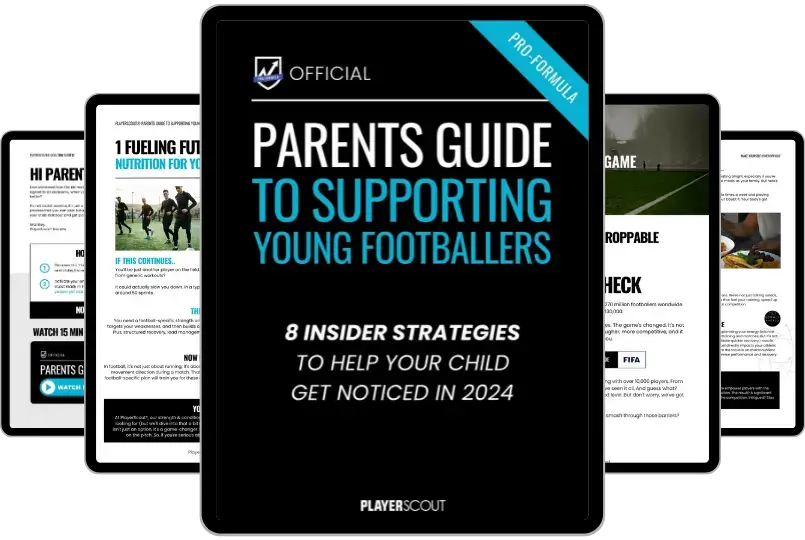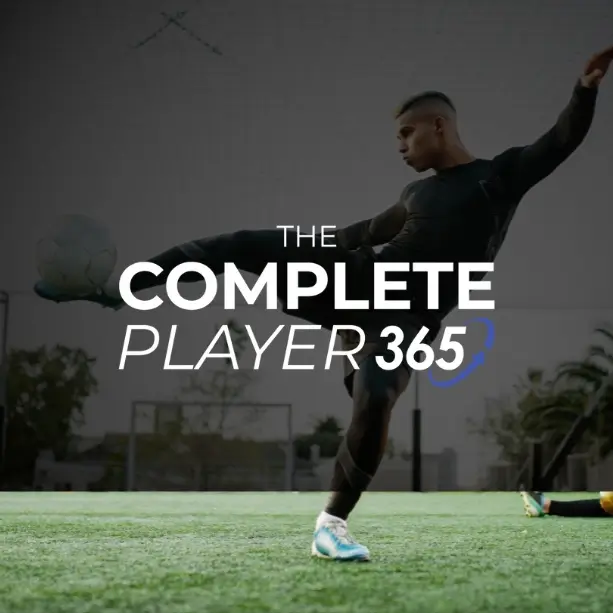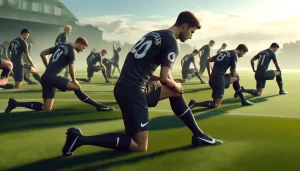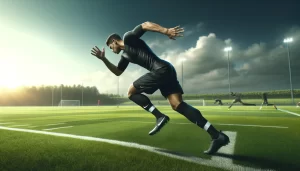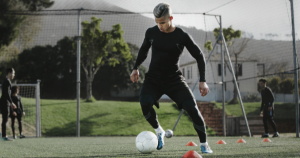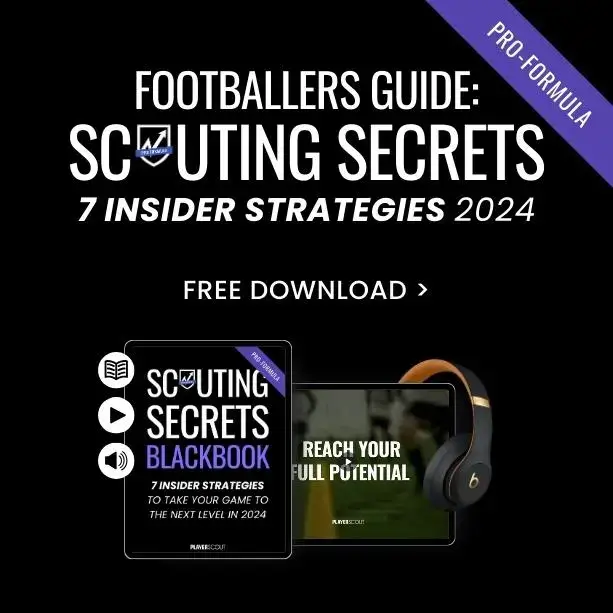Free kicks offer an easy opportunity to score a goal, and can make you an indispensable part of your team, which is why learning how to take a free kick is essential, even as a defender. They are however also very tough, so you need lots of practice and a good solid technique which you can replicate under pressure.
Taking a free kick in football has 2 approaches depending on your game play situation and team player locations. These are the Curl Shot free Kick and the Driven Shot Free Kick. Both of these free kick styles share the same set up, but follow a different kicking pattern.
Before taking a free kick it is important that you are able to get in the zone and to concentrate by blocking out the sounds around you and focusing on your target, so take your time to consider:
- Where the free kick is positioned on the pitch
- What do you know about the goalkeeper and his preferred diving side or game play
- Where is the wall, and where it the goalkeeper standing
These considerations help you to work out how you will hit your target. It is also worth considering how you will strike the ball. For example if you will use:
- A hard straight kick – To make it travel straight and far
- Top spin
- A curl – To make it harder for the goalkeeper to connect with the ball when it reaches them
- Knuckleball – To cause the ball to dip viciously, causing the goalkeeper confusion
For more on kicking styles see 10 kicking techniques.
How to Take a Free Kick – Curl Shot
The curl shot free kick is ideal for shorter free kicks that are 18–25 yards (16.5–22.9 metres) out from the goal mouth.
Step 1: Choose a spot for putting the ball down with no dirt or uneven terrain. Turn the ball so that the valve is pointing towards you, as this is the hardest part of the ball so will affect your kick. Place the ball on the spot with the valve facing towards you. Kicking the ball form the hardest part will enable your free kick to travel further towards the goal mouth.
Step 2: Walk back 5-7 steps depending on the size of your natural step, and the space available to you. You will use this space to get a good rhythm in run up to actually taking your free kick, to give you more power and direction.
Whilst doing this look at the set-up of the wall and look at the goalkeeper to decide where you want to cross the ball. Take a few deep breathes to give your muscles oxygen and relax them, and also your mind. This will give you the best chances of delivering great technique when it matters.
Step 3: Position your body just to the side of the football. For left footed players you need to stand just to the left of the ball, and for right footed players you need to stand just to the right of the ball.
Step 4: Before taking the free kick glance at your target. To begin the free kick and make the ball curl you need to take a run up to the ball at a medium pace on your toes and as you get nearer increase your speed.
Step 5: Ensure that your final stride is long and fast. This will enable you to get power and speed behind your kick.
Step 6: As you go to take your free kick, place your none kicking foot on the ground around 11 inches from your other foot and hold firm. Using your core muscles will help you to do this.
Step 7: To take your free kick swing your kicking leg backwards without twisting it, as far back as you can comfortably manage so that you can get more power behind your kick.
Step 8: Kick the ball on the outside of your kicking foot, since kicking from the inside of your foot will force you to change the position of your body and posture, which will affect the accuracy of your ball shot.
Step 9: The best aim is to shoot the ball at the top left or tight corners of the goal, as this is the hardest place for goalkeepers to reach. Using a curl shot is ideal since they enable you to accurately place the ball in specific goal zones. By connecting your foot with the low point of the ball, and bringing your foot up over the top, you can create a topspin and dip on the ball.
How to Take a Free Kick – Driven Shot
The driven shot free kick is ideal for longer distance free kicks that are further than 25 yards (22.9 metres) out from the goal mouth.
Step 1: Choose a spot for putting the ball down with no dirt or uneven terrain. Turn the ball so that the valve is pointing towards you, as this is the hardest part of the ball so will affect your kick. Place the ball on the spot with the valve facing towards you. Kicking the ball form the hardest part will enable your free kick to travel further towards the goal mouth.
Step 2: Walk back 10-12 steps depending on the size of your natural step, and the space available to you. This is much further back than the curl shot free kick since you want the ball to travel further, so you need more space to get good distance and speed.
Whilst doing this look at the set-up of the wall and look at the goalkeeper to decide where you want to cross the ball. Take a few deep breathes to give your muscles oxygen and relax them, and also your mind. This will give you the best chances of delivering great technique when it matters.
Step 3: Position your body just to the side of the football. For left footed players you need to stand just to the left of the ball, and for right footed players you need to stand just to the right of the ball.
Step 4: Before taking the free kick glance at your target. To begin the free kick and make the ball curl you need to take a run up to the ball at a medium pace on your toes and as you get halfway between your starting point and the ball increase your speed.
Step 5: it is really important to ensure your final stride is fast and long to enable the ball to travel a long distance at speed.
Step 6: As you go to take your free kick, place your none kicking foot on the ground around 11 inches from your other foot and hold firm. Using your core muscles will help you to do this.
Step 7: To take your free kick swing your kicking leg backwards without twisting it, as far back as you can comfortably manage so that you can get more power behind your kick.
Step 8: Kick the ball on the hardest part which has the valve at the centre of it, to enable it to travel straight.
Step 9: The best aim is to shoot the ball at the top left or tight corners of the goal, as this is the hardest place for goalkeepers to reach. This is a lot hard to do with the driven shot free kick since you require so much speed and power behind the ball to make it travel further.
How to take an unstoppable Free Kick
As with all football skills, delivering an unstoppable free kick takes a lot of practice. Since Free kicks are such a crucial part of your game and depend on accuracy, Player Scout recommends you spend 30 minutes out of every training session just purely to practice your free kicks. This is the minimum a professional would practice for.
A free kick isn’t just about mastering your technique. By practicing over and over again you programme your sub continuous to memorise the muscle positions, which improves you agility, and the more familiar you become with your free kick style, the more your confidence grows.
As a player you will face game situations that require you to take a free kick which can determine even the outcome of the final score, so it is critical you have the skills and confidence to take an unstoppable free kick under pressure when it really matters, and this takes practice.
Before taking the free kick as you are taking your position, visualise where you want to kick the ball, and once the ball is on the spot, use your steps backwards to look directly at where you want the ball to go and visualise it going there. This will enable you to put the right pace on the ball to hit the part of the goals target you wish it to hit.
Top tips for taking a free kick
- Practice for 30 minutes every training session in a variety of pitch areas using both the curl shot free kick and also the driven free kick
- Visualise the ball going exactly where you want it to go
- Ensure you take a deep breath to relax your muscles before taking the free kick


